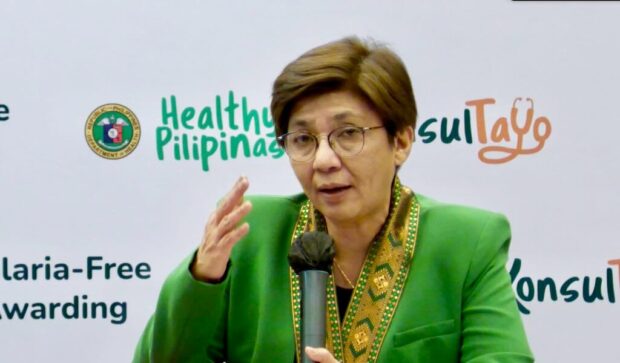DOH: Consider steps taken during pandemic vs seasonal flu

FILE PHOTO: Health Undersecretary Maria Rosario Vergeire. Noy Morcoso/INQUIRER.net
The Department of Health (DOH) on Thursday said it is expecting the incidence of influenza-like illnesses (ILI) in the country to continue to rise due to the “proliferation of viruses” during the rainy season and cooler months.
As of Sept. 16, DOH figures showed that a total of 134,637 ILI cases have been reported since the start of the year. This is an 8-percent increase from the confirmed ILI infections two weeks ago.
The health department noted that ILI infections in the past month have been climbing, attributing the case trend to the transitioning weather conditions—“from increased heat and high humidity in the summer to wet and damp weather conditions.”
The World Health Organization defines ILI as an acute respiratory infection with a measured fever of 38 degrees Celsius and above, accompanied by cough for around 10 days.
COVID-19 cases in the country, meanwhile, climbed to an average of 176 per day, or a total of 1,231 infections last week, based on the latest weekly case bulletin.
Article continues after this advertisementThe figure was a slight increase from the previous daily average of 166 cases, or a total of 1,164 infections from the prior week of Sept. 18 to Sept. 24.
Article continues after this advertisementDuring the budget deliberations in the Senate last week, Health Undersecretary Maria Rosario Vergeire allayed fears that the ILI reported in various schools in Cagayan de Oro City was due to the spread of the contagious zoonotic disease Nipah virus.
The former DOH officer in charge advised the public “to not panic” as she attributed the infections to “increasing cases of flu-like illnesses” in the country.
“We just have to do [the preventive measures] we did during COVID-19 [pandemic]—washing of hands, and [wearing of] masks when vulnerable because we can get it through close contact or droplet infections also and from fluids of bats,” she told lawmakers.
‘Active surveillance system’
In a media forum on Tuesday, Dr. Fatima Gimenez, president of the Pediatric Infectious Diseases Society of the Philippines, pressed the government for an “active” surveillance system—one that could monitor which viruses are circulating even before an outbreak occurs—amid reports of ILI in schools that led to class suspensions.
She pointed out that they’ve been wanting “since years back” this kind of infectious disease surveillance in the Philippines to curb the spread of contagious diseases, especially among children.
What the country implements through the DOH, Gimenez noted, is a “passive” surveillance system, where data on illnesses spreading among the population are routinely collected from health-care facilities.
Among the contagious illnesses affecting children in recent weeks, she said, are influenza and respiratory syncytial virus, the vaccines for which were only made available for the first time in May in the United States.
For Dr. Vicente Belizario, professor at the College of Public Health at University of the Philippines Manila, the DOH “needs adequate support from the [Research Institute for Tropical Medicine] and other reference laboratories because “they should tell us what virus [is circulating], what it is about, and what strain it is for instance.”
Such a system is crucial so the DOH could “convey the right message” to the public, he said.